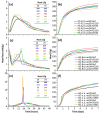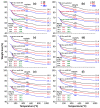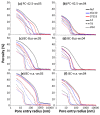Portland and Belite Cement Hydration Acceleration by C-S-H Seeds with Variable w/ c Ratios
- PMID: 35629580
- PMCID: PMC9147420
- DOI: 10.3390/ma15103553
Portland and Belite Cement Hydration Acceleration by C-S-H Seeds with Variable w/ c Ratios
Abstract
The acceleration of very early age cement hydration by C-S-H seeding is getting attention from scholars and field applications because the enhanced early age features do not compromise later age performances. This acceleration could be beneficial for several low-CO2 cements as a general drawback is usually the low very early age mechanical strengths. However, the mechanistic understanding of this acceleration in commercial cements is not complete. Reported here is a contribution to this understanding from the study of the effects of C-S-H gel seeding in one Portland cement and two belite cements at two widely studied water-cement ratios, 0.50 and 0.40. Two commercially available C-S-H nano-seed-based admixtures, i.e., Master X-Seed 130 and Master X-Seed STE-53, were investigated. A multi-technique approach was adopted by employing calorimetry, thermal analysis, powder diffraction (data analysed by the Rietveld method), mercury intrusion porosimetry, and mechanical strength determination. For instance, the compressive strength at 1 day for the PC (w/c = 0.50) sample increased from 15 MPa for the unseeded mortar to 24 and 22 MPs for the mortars seeded with the XS130 and STE53, respectively. The evolution of the amorphous contents was determined by adding an internal standard before recording the powder patterns. In summary, alite and belite phase hydrations, from the crystalline phase content evolutions, are not significantly accelerated by C-S-H seedings at the studied ages of 1 and 28 d for these cements. Conversely, the hydration rates of tetracalcium alumino-ferrate and tricalcium aluminate were significantly enhanced. It is noted that the degrees of reaction of C4AF for the PC paste (w/c = 0.40) were 10, 30, and 40% at 1, 7, and 28 days. After C-S-H seeding, the values increased to 20, 45, and 60%, respectively. This resulted in larger ettringite contents at very early ages but not at 28 days. At 28 days of hydration, larger amounts of carbonate-containing AFm-type phases were determined. Finally, and importantly, the admixtures yielded larger amounts of amorphous components in the pastes at later hydration ages. This is justified, in part, by the higher content of amorphous iron siliceous hydrogarnet from the enhanced C4AF reactivity.
Keywords: C-S-H nano-seeding; CO2 footprint; Rietveld analysis; accelerators; ettringite.
Conflict of interest statement
The authors declare no conflict of interest.
Figures







References
-
- UN Environment. Scrivener K.L., John V.M., Gartner E. Eco-efficient cements: Potential, economically viable solutions for a low-CO2, cement-based materials industry. Cem. Concr. Res. 2018;114:2–26. doi: 10.1016/j.cemconres.2018.03.015. - DOI
-
- Juenger M.C.G., Siddique R. Recent advances in understanding the role of supplementary cementitious materials in concrete. Cem. Concr. Res. 2015;78:71–80. doi: 10.1016/j.cemconres.2015.03.018. - DOI
-
- Juenger M.C.G., Snellings R., Bernal S.A. Supplementary cementitious materials: New sources, characterization, and performance insights. Cem. Concr. Res. 2019;122:257–273. doi: 10.1016/j.cemconres.2019.05.008. - DOI
-
- Cuesta A., Ayuela A., Aranda M.A.G. Belite cements and their activation. Cem. Concr. Res. 2021;140:106319. doi: 10.1016/j.cemconres.2020.106319. - DOI
-
- Flatt R.J., Roussel N., Cheeseman C.R. Concrete: An eco material that needs to be improved. J. Eur. Ceram. Soc. 2012;32:2787–2798. doi: 10.1016/j.jeurceramsoc.2011.11.012. - DOI
Grants and funding
LinkOut - more resources
Full Text Sources
Research Materials
Miscellaneous

